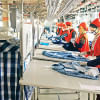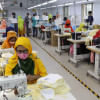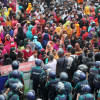A garment powerhouse
Walk down the road in Savar, Gazipur or Narayanganj in the morning hours and you will see a long line of workers heading to work. They will soon join the production lines behind silent brick walls to make clothes for the world. The garment industry, home to 40 lakh workers, is one of the largest employers, fetching $47 billion in annual exports, a milestone Bangladesh crossed in 2023. Behind this growth story exists another group -- fashion retailers perpetually in pursuit of low-cost products.
After a journey of nearly five decades, Bangladesh has morphed into the second-largest garment exporter in the world after China, accounting for 7.9 percent of the global market share. It is now the mainstay of Bangladesh's economy with the sector's rapid growth and modernisation over the past decade. The transformation of the garment industry was catalysed, in part, by a series of workplace tragedies, including the Rana Plaza disaster that took the lives of more than 1,100 workers. In those dark days, retailers stayed with Bangladesh in a push for workplace compliance. The groundbreaking International Accord that made jobs safer for millions of garment workers in Bangladesh was later extended to Pakistan.

It is now expected that Bangladesh's share in the global market will continue to grow. The Bangladesh Garment Manufacturers and Exporters Association (BGMEA) aims to capture 12 percent of the international market share by 2026 when Bangladesh is scheduled to graduate from the group of the least-developed countries. That partly depends on the retailers' appetite for Bangladesh as the nation will lose most of the duty benefits after LDC graduation.
Initially, Bangladesh's garment industry grew under a quota system introduced by an international trade agreement, known as the Multifibre Arrangement (MFA), in 1974. The MFA, which persisted until January 2005, imposed quotas on the amount of clothing and textiles that developing countries could export to developed nations. Thanks to the agreement, the garment sector found a niche in the market for many years and continued to thrive.
However, the main role was played by the buyers, who flocked to Bangladesh to source clothing items at competitive prices.
With local garment makers working under the cutting and making (CM) method, the onus was on the buyers to play the vital role of supplying designs, patterns, fabrics and raw materials. The CM method, which involves costs of cutting, sewing, pressing, folding and packing, is still popular in Bangladesh, with suppliers mainly doing so to avert risks.

In the late 1970s and mid-1980s, buyers used to place orders in small quantities and the sales of garment items were mainly facilitated by third-party vendors because the size and scale of businesses were so small that international retailers and brands were uninterested in placing direct orders.
However, with time, major retailers and brands, especially from Europe and the US, started arriving here and directly purchasing goods. About 50 of them now have liaison offices in Bangladesh, allowing them to buy garment items at competitive prices. By and large, Bangladesh has proven itself as a reliable supplier of value-added garment items while also growing by leaps and bounds in design and pattern-making.
Bangladesh cemented its position during the peak of the coronavirus pandemic when it kept its factories open except for the initial few months of the health crisis in 2020 while factories in all other supplying nations were shut for many months at a stretch.
Of the $47 billion worth of exports of garment items last year, the lion's share was shipped through a direct purchasing method by retailers and brands. With direct sales, both buyers and suppliers benefit as no third party shares the profit. However, many small buyers, who can't afford an overseas office, still rely on third-party vendors.
Swedish retail giant H&M is the largest buyer of Bangladeshi clothes, purchasing items worth nearly $4 billion annually. The country is also the single largest sourcing destination for H&M, which has its own office in Dhaka.
US retail giant, Walmart, is the second-biggest buyer of Bangladeshi apparel, procuring nearly $2.5 billion worth of products a year. It was the largest buyer for the country for many years before ceding the top spot to H&M in recent years.
Spanish company Inditex, which owns brands like Zara, Pull&Bear, Massimo Dutti, Bershka, Stradivarius, Oysho and Zara Home, buys nearly $2 billion worth of garment items from Bangladesh every year.
Shafiur Rahman, regional operations manager of G-Star in Bangladesh, said Bangladesh will remain an important sourcing destination for his company in future. G-Star Raw, a Dutch designer clothing company, buys nearly $1 billion worth of garments, including denim and T-shirts, from Bangladesh a year.

"We will keep sourcing the same amount of clothing in 2024, anticipating slight growth in the fourth quarter onward," said Rahman.
British retail giant M&S procures more than $2 billion annually from Bangladesh. Japan's Uniqlo has turned into nearly a billion-dollar buyer. Of the $1.6 billion worth of garment items exported to Japan last year, the majority was secured by the Japanese retailer alone.
Japan has remained a major destination for Bangladesh since 2011, when Tokyo started allowing zero-duty benefits to the LDCs for garment items and knitted items, even if they are made from imported fabrics.

With such a major trade benefit in place, Japanese clothing retailers started clamouring to Bangladesh and thus Japan became the largest export destination for the country in Asia.
Irish retail giant Primark has ramped up purchases, with their annual purchases now valued at nearly $2 billion.
Puma, Nike, PDS, Adidas, Gap, Levi Strauss & Co, VF Corporation, PVH Corporation, Old Navy, Banana Republic, Sainsbury's, Esprit, and C&A are some other major buyers, with each buying nearly $1 billion worth of clothes from Bangladesh a year.
The sourcing pattern from Bangladesh has also changed a lot over the years because of the changing habits of buyers and consumers, and the sales of retailers and brands.
Many top retailers and brands source garment items in small quantities but at higher prices. For instance, Hugo Boss, a German luxury fashion brand, procures garment items worth a few hundred million.


 For all latest news, follow The Daily Star's Google News channel.
For all latest news, follow The Daily Star's Google News channel. 






Comments